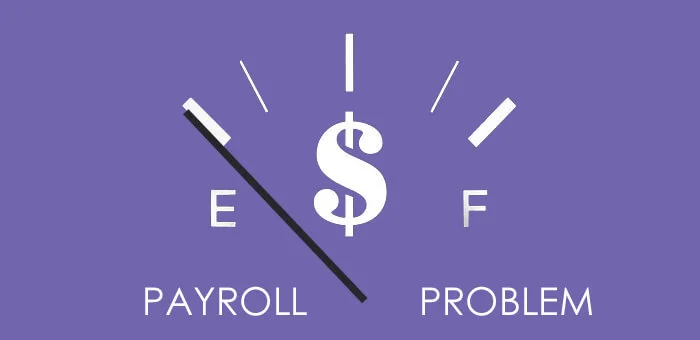How a business line of credit helps your construction company meet payroll
Your construction company is growing. But it’s slow season now, cash isn't coming in…and your people still need to get paid.

Anyone who has a construction business knows that the industry has cash-flow issues all its own. While other industries sometimes solve cash-flow issues by delaying payroll, that’s the last thing you want to do. Your people need to feed their families, and when they can’t, they can’t work well, either.
So you need to find a way to make payroll on time without dipping into your own personal account to do it.
In this post we talk about:
- The cash-flow challenges construction contractor businesses face
- How a business line of credit can help
- How you can improve your eligibility for a bank line of credit
- Alternative loans & sources of funding beyond a bank line of credit
Why do construction companies and contractors have so many cash-flow issues?
While almost all businesses hit cash-flow snags, the nature of the construction industry causes it to be unusually prone to them:
It’s a seasonal industry.
Weather conditions wreak havoc on construction projects and contractors like roofers. Not only are there seasons where the demand is low; even when a project is underway, bad weather conditions can cause delays and throw the entire project off-schedule. Those delays filter down to AR, delaying much-needed payments as well.
Funding needs to be available.
Construction contractors are usually funded by banks or private owners. If your funding source is a bank, then it’s up to you, as the contractor, to keep the project going and the workers paid until the next payment is deposited.
Shady actors have given the industry a bad name.
Even when a project is privately funded, the funds aren’t necessarily all available at once.
Why? Because the construction industry has more than its share of shady companies that take up-front deposits, then fail to deliver.. This has a direct effect on you, because owners protect themselves by not releasing more funds at a time than they absolutely have to. So again, it’s up to you as the contractor to find other funds that keep payroll running smoothly until the next payment is made.
Government payouts are slow.
While government contracts can be highly lucrative, they’re also highly challenging because government payouts are notoriously slow. Those delays are a major headache for contractors, not least because they cause cash-flow problems and wreak havoc with payroll.
KEEP IN MIND:
None of these factors mean that the construction company or contractor in question aren’t successful. These issues are common to the industry, and almost every company needs to find solutions for them.
So what do you do? How do you meet payroll needs despite these cash flow challenges?
One of the first solutions construction companies turn to is a business line of credit.
Read more about business lines of credit and how they work =>
If cash-flow issues are so common in the construction industry, how can contractors qualify for a business line of credit?
Great question.
It’s true that seasonality and general cash-flow issues mean that banks often regard contractors as high-risk. That doesn’t mean you’re powerless, though. There are four areas of your business that can show your bank that you’re stable, growing, and can handle a business line of credit.
FINANCIAL HEALTH
The first priority when applying for a business line of credit is to demonstrate to the bank that your business is financially healthy. Here’s what you need to show:
- Good credit history. Good credit history is a major indicator of stability. If you’ve been paying bills and loans on time, your bank needs to see that.
- Consistent cash flow. Highlight the times when your cash flow is consistent. If your challenges are seasonal or a consequence of issues beyond your control, that’s another point in your business’s favor.
- Profitability. A healthy profit margin will go a long way toward showing your bank they can rely on you. Make sure all your financial statements are in order and that they’ve been reviewed and approved by an accountant.
💡 Pro tip: Don’t try to hide outstanding debt or other potentially damaging financial data. The bank will discover it eventually and your credibility will be ruined. Instead, highlight the way you dealt with the issues promptly and responsibly.
TRACK RECORD
The second way to boost your eligibility for a business line of credit is to showcase your track record.
- Successful projects. The more completed projects you have, the more stable your business will appear. So prepare brief case studies showing the metrics (costs, timelines, revenue) for every project you completed successfully.
- Excellent budgeting. There’s only one thing better than a successfully completed project: A project that was successful and was completed on time and within budget.
- Industry reputation. You’ve likely built good relationships with suppliers, clients, and other contractors. If you haven’t, start now; the bank will want to know what other players in your industry are saying about you.
💡 Pro tip: When you work with a satisfied client, supplier, or contractor, ask them for a testimonial at the end of the project. That way you’ll have that reputation asset ready when you need it.
STRONG BUSINESS PLAN
After you’ve got your financials and your track record together, you need to make sure you have a solid business plan.
While getting into the details is beyond the scope of this article, any strong business plan should include the following sections: Introduction/executive summary, company description, market analysis, marketing strategy, operations, financial plan, conclusion.
You can use free templates like this one to guide you through it.
RELATIONSHIPS
The better your relationships with your suppliers, contractors, and clients, the better your reputation.
Banks look very closely at what the people you work with say about you, and the kind of rating you have within your industry. Broadly, your bank will want to see that you are:
Once I’ve done all that, how do I get a business line of credit?
You have a number of options when it comes to a construction line of credit. The first and most obvious is, of course, your bank.
It’s imperative to choose a bank that has a good history of working with construction companies like yours.
The construction business has unique needs and risks. A bank with industry experience is in a much better position to evaluate those needs and risks objectively and within context. They’re also far more likely to understand the potential of funding your business, and to offer creative, customized solutions with better rates that take those needs into account.
Once you’ve chosen a bank, your next step is to cultivate a relationship with the bank in general and your loan officer in particular.
Be friendly. Ask how they’re doing. If you have common interests, talk about them. Send them greeting cards before holidays. The more they feel invested in their relationship with you, the more they’ll be willing to push the envelope for you, too.
Read more about how to nurture a good relationship with your bank =>
Alternative funding for construction loans
The obvious drawback to a bank line of credit is that it’s a long process. When you need to buy supplies, order materials, and make payroll, time is a critical factor.
Fortunately, there are other financing options for contractors and construction companies.
One well-known alternative is accounts receivable, or AR, financing, where your lender provides you with cash advances and uses unpaid invoices as collateral.
Invoice factoring works similarly: A third-party lender purchases your unpaid invoices at a discount. That provides you with immediate cash flow, which you can use to keep your project going.
One that isn’t commonly spoken about is mobilization financing. This type of financing is ideal for construction projects because it covers unfinished goods or workforce for a project as long as a contract is signed.
A fourth option is advance payroll funding. In this scenario, a payroll financing company extends a business line of credit specifically for covering payroll. Your workers get paid on time, and the money you had set aside for payroll is now freed to be used for other expenses. One of the biggest advantages of payroll financing is that the approval process is much faster. Here at Payro, for example, the onboarding approval process takes just two business days. Once a business is approved, they get same-day funding.
Read more about how construction companies can benefit from Payroll financing loans ->
👍 Keep in mind: Payroll loans can only be used to cover payroll. However, you can use money freed up from payroll to cover other expenses.
Yes, the construction industry has unique payroll and cash-flow challenges that banks don’t always understand. But that doesn’t mean your company can’t get the business line of credit or other funding option it needs. By taking steps to improve your eligibility, choosing your financial institutions wisely, and considering out-of-the-box solutions beyond your bank, you’ll be able to meet deadlines, hit payroll consistently, and grow your business.
Morris Reichman
hello@payrofinance.comMorris Reichman is the founder and CEO of Payro Finance. Former Vice President at Infinity Capital Funding an alternative finance company, Morris possesses a versatile background in the finance industry. Having spent 7+ years working across global macro operations and start up corporate finance Morris's expertise is in business accounting, risk management and investment analysis. Morris founded Payro Finance to support business owners and ensure their business continuity.
Need a short-term loan to cover payroll?
Apply in under two minutes, and get approved within 2 days. Once approved, funds are in your account the same day.
- Always 1.5% weekly
- Up to $500,000
- Same-day funding


